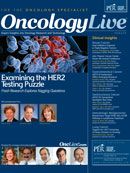Support for LDCT Screenings of Heavy Smokers Is Growing
The concept of screening people at high risk for developing lung cancer with low-dose computed tomography continues to gain support in the oncology community.
Román Pérez-Soler, MD
Professor of Medicine, Chief, Division of Oncology, Montefiore Medical Center, Albert Einstein College of Medicine, Bronx, NY
The concept of screening people at high risk for developing lung cancer with low-dose computed tomography (LDCT) continues to gain support in the oncology community. The National Comprehensive Cancer Network (NCCN) has published guidelines for screening people with a history of heavy smoking, and a patient advocacy group recently announced plans for a national campaign to promote screening.
Such screenings represent the potential for a dramatic leap forward in treating patients, lung cancer specialist Román Pérez-Soler, MD, said in an interview. Lung and bronchial cancers constitute the leading cause of cancer death in the United States, accounting for 29% of cancer deaths among men and 26% among women, according to the American Cancer Society.
“I have always been in favor of the screening. Of course, we didn’t have the definitive evidence until now,” Pérez-Soler said, referring to the results of the National Lung Screening Trial (NLST). “I always thought it was a very simple idea that made so much intuitive sense that it had to work.
“Now we have something to do—a strategy for the heavy smokers—and I think the impact of this screening appears to be that it’s going to represent a major change in terms of the cure rate of the disease,” said Pérez-Soler. “We’re going to be able to treat the disease early on in many cases.”
The impetus for LDCT screenings has been building since the results of the NLST were announced in November 2010. The trial involved more than 53,000 current and former heavy smokers randomized for screening with LDCT or a standard chest x-ray. There were 20% fewer lung cancer deaths among those screened with LDCT.
The NCCN incorporated recommendations for screenings into its guidelines approximately a year later, in November 2011.
The NCCN recommends a baseline screening for people aged 55 to 74 years with a ≥30 pack-year history of smoking and smoking cessation <15 years, and for those aged 50 and older with a ≥20 pack-year history of smoking and an additional risk factor other than second-hand smoke, such as a family history of lung cancer or a personal history of pulmonary disease. (A pack-year is calculated based on the number of cigarettes smoked per day and the number of years the person has smoked.)
Follow-up screenings are recommended based on the presence, size, and type of nodules found in the initial scan.
In February, the Lung Cancer Alliance launched a framework for promoting LDCT screenings, including a “bill of rights” for at-risk people and principles for establishing testing centers.
Pérez-Soler said screenings would allow for earlier identification of lesions, when they should theoretically be less molecularly complicated, and set the stage for monitoring patients for the second tumors common in the disease.
“It’s going to shift the attention to populations at risk, identifying tumors that are resectable, resecting them, and still have the population that continues to be at risk for other cancers being followed regularly so that second tumors can also be detected on time,” he said.
Román Pérez-Soler, MD, is the program director for the 7th Annual New York Lung Cancer Symposium scheduled for November 10, 2012, in New York City.




